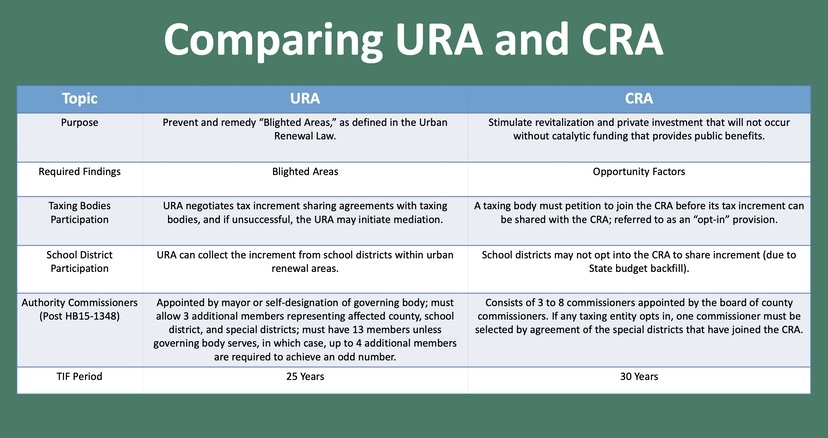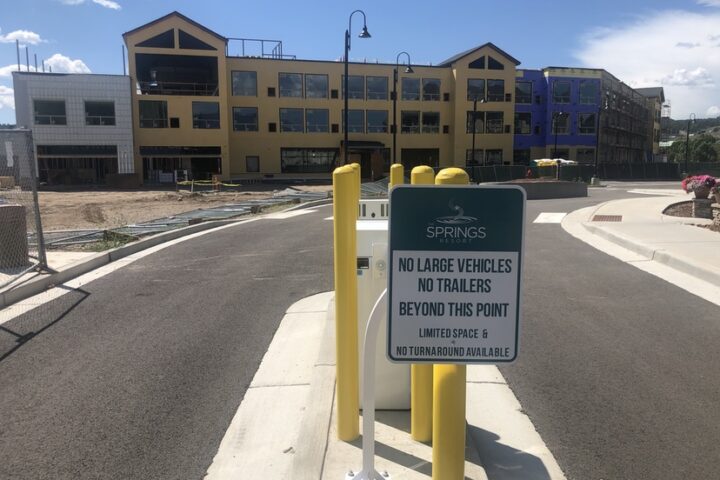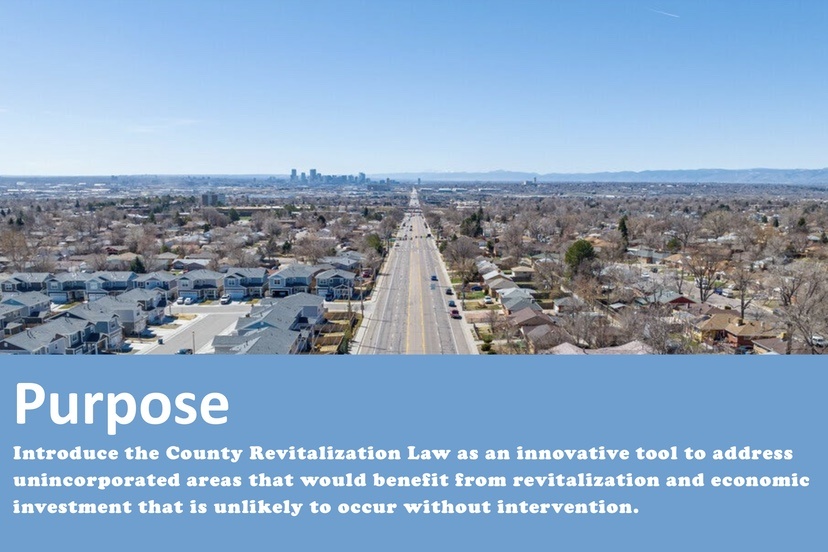I find the photo above to be interesting. It was shared as part of a January 7 presentation by Emily Lashbrooke, Executive Director of the Pagosa Springs Community Development Corporation (PSCDC) giving a brief but informative summary of HB24-1172, Colorado’s new ‘County Revitalization Law’.
I assume we are on the outskirts of Denver, hovering over a five-lane ‘stroad’ — an arterial that is not quite a street and not quite a road. To the right, we see an older suburban neighborhood of one-story single-family homes and mature trees. To the left, we see a newer neighborhood of larger two-story homes without any mature trees. It’s easy to imagine that the larger, newer homes on the left sell for twice the price of the smaller, older homes on the right.
It’s also easy to imagine that some people — perhaps even some county commissioners — could view the older, less expensive neighborhood as being in need of “revitalization”.
I had not heard of HB24-1172, prior to Ms. Lashbrooke’s January 7 presentation. It was signed into Colorado law by Governor Jared Polis last June, and now allows for “County Revitalization Authorities”. “CRAs”
“Powerful redevelopment tools.”
Yet another reason for us to be concerned about “Economic Development”.
From the Colorado General Assembly’s website:
County Revitalization Authorities
Concerning county revitalization authorities.
Session: 2024 Regular Session
The Act creates a process for the establishment of a county revitalization authority (authority). An authority is a corporate body that uses tax increment and private financing to conduct a county revitalization project (project) in a revitalization area in accordance with a county revitalization plan.
A county revitalization plan (plan) is a plan for the project. A plan must be: Reviewed by the county planning commission, accompanied by a county revitalization impact report, the subject of a public hearing, and approved by the board of county commissioners (the governing body). Any modifications to the plan must also be approved by the governing body. A plan may provide for tax increment financing.
I hope you can bear with me as we explore the promise of the County Revitalization Authority. It’s a complicated story.
In the presentation for the BOCC last month, Ms. Lashbrooke shared this slide:

Let’s travel back to 1958. The federal government has made a commitment to fix American cities. In particular, the federal government would like to get rid of slums, and to that end, is making millions of dollars available to cities for “slum clearance” projects.
Colorado is still overwhelmingly rural and agricultural in 1958. But there’s some federal money available, and the General Assembly would like Colorado to get their hands on some of it, so they pass the Urban Renewal Act. This act, modeled on laws in other states, allows municipalities to identify “blighted areas” and use “Tax Increment Financing” for urban renewal. To get rid of the slums… that don’t really exist in Colorado.
Looked at from a slightly different angle, it allows municipalities to destroy affordable housing, move out the poor people, and build commercial buildings or middle- and upper-class housing in its place. Using “Tax Increment Financing”. “TIF”.
In other words, tax subsidies.
You may notice the references to “tax increment” in the chart above. I was schooled in Tax Increment Financing back in 2019, when developer David Dronet — managing principal at the Springs Resort — approached the Town of Pagosa Springs with a plan for an “Economic Development” project.
He proposed that the Town create an Urban Renewal Authority (a URA,…something the Town had never considered doing previously, in spite of the Law dating from 1958) and redirect $79 million in future property taxes to the Springs Resort, to facilitate a multi-million-dollar resort expansion. His partner in the project, Jack Searle, assured the Town Council that the expansion could not happen without government subsidies.
This project would move forward, we were told, only if the community authentically wanted the Resort to expand, and to benefit from $79 million in government-guaranteed tax subsidies.
Mr. Dronet asserted — as did his consultants — that the site for this proposed resort expansion qualified as “urban blight”.

For whatever reason, the Town Council, on the advice of their legal counsel and Planning Department, did indeed determine that the open meadows south of the Springs Resort — shown above — constituted “urban blight”. Mr. Dronet and the Springs Resort seemed to have obtained the go-ahead for a tax-subsidized 27-acre development. The tax revenues would be diverted from the School District, the Fire District, the Water Districts, the Library District, the Medical Center, and the County government… and according to Colorado’s Urban Renewal law, the decision to divert the taxes to Mr. Dronet’s project could be made by the Town Council without getting permission from the other government entities.
But the community would get a greatly-expanded resort on a “blighted” property, by way of “urban renewal”. Right?
A small group of concerned citizens, however, thought it would be appropriate for the taxpayers to be able to weigh in on such decisions, rather than allow a majority of an elected Town Council — four people — to have the final say about a $79 million tax giveaway. An amendment to give the voters control over large tax giveaways was placed on the Town ballot and was approved by a sizable margin.
The Springs Resort never brought their tax-funding proposal to the voters for approval, however.
Instead, they went ahead and built the new hotel they had previously assured the Town Council they could not afford to build without government subsidies.

We can understand the Town government wanting to be the economic heroes of the community. And there’s little doubt that yet another luxury hotel will create jobs in Archuleta County. The hotel will need maids, and desk clerks, and janitors, and massage therapists. Nearby restaurants and gift shops will benefit from the additional tourist bookings.
And aren’t jobs a good thing to have?
In fact, a full-blown economic crisis has been unfolding in Archuleta County over the past decade. But the crisis is not a ‘lack of jobs.’ The crisis is a lack of employees to fill the jobs we already have. Nearly every day, I hear someone from a local government agency or from a local business complaining that they cannot find qualified workers.
And even when a suitable employee can be found, the employee often cannot find a place to live in Archuleta County. This employee can’t find a place to live, partly because most of the homes being built in our community are intended for vacation rental investors, wealthy retirees, and second-home owners.
The Urban Renewal Authority and its clever TIF funding mechanism has been available to municipalities since 1958. But this mechanism has not been available to county governments.
Now, as of 2024, we have the County Revitalization Authority law to help drive “Economic Development”.
Note that we’re no longer talking about ‘Urban Renewal’. We’re talking about ‘Revitalization”.
Which, I suspect, can mean almost anything.

